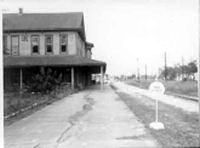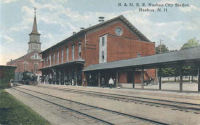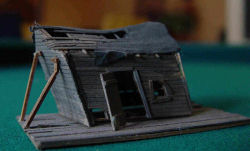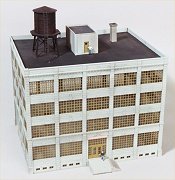Model Structures Set Tone For Railroad Layout
|

|
Scale Structures
Through
Kit-Bashing or
Scratch Building |

|
|
|
Building dioramas and other model layouts that involve more than a single
subject can get pretty involved and if you are talking more than 5 or 6
structures, can start to resemble a real estate investment.
And
it is worse than house hunting, you can never find the building model that
is in your scale, has a footprint for the area you have available, serves
a logical purpose, and has the look you want.
You
will find a variety of manufacturers work off the same plans storehouse
and as a result, come up with kits that very closely resemble one another.
There
are alternatives.
Two
of the most popular are kitbashing and scratchbuilding. A third player is
cardstock modeling of buildings and other structures. These are available
as downloadable products. They can be reduced or blown up to the scale you
are working with and then assembled without much of a fuss.
It is
the building from scratch and altering of kits (usually plastic) that
requires a little more thought and planning.
Bear
in mind that when it comes to model railroad layouts, the buildings serve
the layout. In other words trains need a purposeful destination before
track is laid. You don’t lay track and then try to find a building that
will fit a particular siding.
At
some point in the planning process the buildings and the tracks will need
to come together. If you aren’t sure what will fit where pull together a
list of the desired buildings complete with footprint dimensions. Cut the
“footprints” out of cardboard locate them on the layout and then stream
track in an around them. |
|
Bashing
A Kit
This is a method I used
successfully to create a railroad shed (right) and a granary for an
N-Scale layout. I will to briefly cover kit bashing as it is similar to
scratch building. In kit bashing I use parts from several kits to get a
completely different structure.
Find a structure you
want to build now what? All buildings can be broken down into smaller
components, look at the overall building to see the logical breaks or
boxes. Look to see how it would be built in the real world. Then put your
model together the same way. |
|
 |
| A dilapidated line shack |
|
|
If you want to show the interior, you should finish that as
well and make your roof removable. If you do not intend to finish the
interior, it is much easier to do the roof. For removable roofs to look
good, I have always built them with rafters and cross bracing to give them
stability and strength.
If you are kit bashing to
produce a building you will need to have in mind the building purpose and
ultimate sitting when you are trying to figure out what walls you can
keep, which must go and how you will deal with the roof elements of the
structure.
Bear
in mind the roof is of prime importance in a model because the viewer is
looking down on the structure and sloppy fitting roofs will do more than
leak.
Given
a plastic wall, brick, stone or clapboard, there isn’t much that can’t be
used in some type of building so be careful what you throw away. A good
junk bin is a modeler’s best friend.
Building
From Scratch |
 |
Compared to kit-bashing, scratch building structures
offers a lot of individualism as modelers pretty much have their
choice of materials for construction. Instead of using existing
parts or complete kits. After kit-bashing a couple of buildings for
my woodshed railroad empire in N Scale, I started one from scratch.
This is a factory built to resemble one in Nashua, NH
Building stock for
scratch building can be plain sheets, strips, bars, tubes, rods, or
even structural shapes such as L or T girders - stock can also be
embossed or textured and even printed to reproduce a certain
prototype material (such as plastic sheet embossed with grooves to
mimic scale siding). |
|
|
For example, to scratch-build a small board fence for a
military diorama, modelers could use plastic rod stock or melted sprue
(depending on scale) to form the vertical posts, then use plastic bar
stock to form horizontal rails affixed to the posts, lay plastic strip
stock vertically on the horizontal rails (distressed with a wire brush to
mimic wood grain - additionally the modeler can use thin strips of actual
wood), trimming the top and bottoms of the strips to be even, add
detailing like nail holes (using a small pin), and then finishing and
distressing (weathering, or making a model look like it has been used via
dust, dirt, stains, and wear). Note that because of the ease in cutting,
shaping, gluing, and finishing it, plastic is the favorite material of
scratch-builders (who over the decades have used material ranging from
wood and metal to foamboard and gravel). |
| There are
several ways to create designs for scratch building projects ranging from
scaling photographs to get accurate dimensions, but generally modelers
gets plans of a prototype, or designs his own, transfers these plans to
paper or other material as patterns (much easier since the arrival of
household computer printers and copiers), and uses these patterns to cut,
trim and affix the stock together to form the model. Finishing work (such
as sanding and polishing, painting, weathering, distressing by forming
dents and rust, dust, etc.) is done to complete the model and (hopefully)
bring it to a life-like state. |
|
 |
|
Nashua's B&M Depot |
|
|
Note: It is perfectly fine for the scratch-builder
of today to use otherwise-hard-to-model commercial detail parts, such as
window castings for structures, or wheels and tires assemblies for motor
trucks, whenever possible - the base model, such as the walls and floors
of the building, or the cab and chassis of the truck, or the sides, ends,
and floor of the freight gondola's is what counts as scratch-building. |
Make Sure Your Building Isn't Mortar Bored
You Can Save on Model Railroad Structures
There are many structure model kits in both wood and plastic you can use to grace your model railroad layout,dioramas, or even structures for slot car raceways. But the cost of these kits is increasing dramatically as the quality sharpens and details increase.
Increasingly, paper and cardstock structure models are offering a practical and economical alternative.
Join The Click-Kits Expansion in 2010
|







